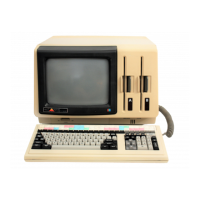CP/M-86
System Overview
1-2
Unlike
CP/M-80,
CP/M-86
does
not
use absolute locations for system entry
or
default variables. The BDOS entry takes place
through
a reserved software inter-
rupt.
Entry
to
the BIOS is provided by a new
BDOS
call.
Entry
to
the extended
BIOS
is
made directly through
an
interrupt vector. Two variables maintained in low
memory
under
CP/M-80,
the default disk
number
and
I/O
Byte, are placed in the
CCP
and
BIOS respectively in
CP/M-86.
Dependence
on
absolute addresses
is
minimized in
CP/M-86
by maintaining inital base page values, such as the default
File
Control
Block
and
default
command
buffer, in the transient
program
data
area.
Utility programs such as
ED,
PIP, STAT,
and
SUBMIT operate in the same
manner
under
CP/M-86
and
CP/M-80.
DDT-86 allows interactive debugging
of
8086
machine code. ASM-86 allows assembly language
programming
and
development
for the
8086 using Intel-like mnemonics.
CP/M-86
includes two utilities
that
replace equivalent
CP/M-80
utilities .
•
GENCMD
(Generate
CMD
file) replaces the
LOAD
program
ofCP/M-80.
It
converts the hex files produced by ASM-86
or
Intel utilities into memory
image
format
suitable for execution
under
CP/M-86
.
•
LDCOPY
(Loader
Copy)
replaces
the
SYSGEN
utility
used
under
CP/M-80.
It
is
used to copy the cold
start
loader
from a system disk for
replication.
Several terms used throughout this manual are defined in Table 1-1.
A
group consists
of
segments
that
are
loaded
into
memory as a single unit. Since a
group
may
consist
of
more
than
64 bytes, it
is
the responsibility
of
the application
program
to
manage segment registers when accessing code
or
data
beyond the first
64K segment.
CP/M-86
supports
eight
program
groups: the code,
data,
stack,
and
extra groups,
and
four
auxiliary groups. When a code,
data,
stack,
or
extra
group
is loaded,
CP/M-86
sets the respective segment register (CS, DS,
SS
or
ES)
to
the base
of
the
group.
CP/M-86
can also load four auxiliary groups. A transient
program
manages
the location
of
the auxiliary groups using values stored by
CP/M-86
in the user's
base page.

